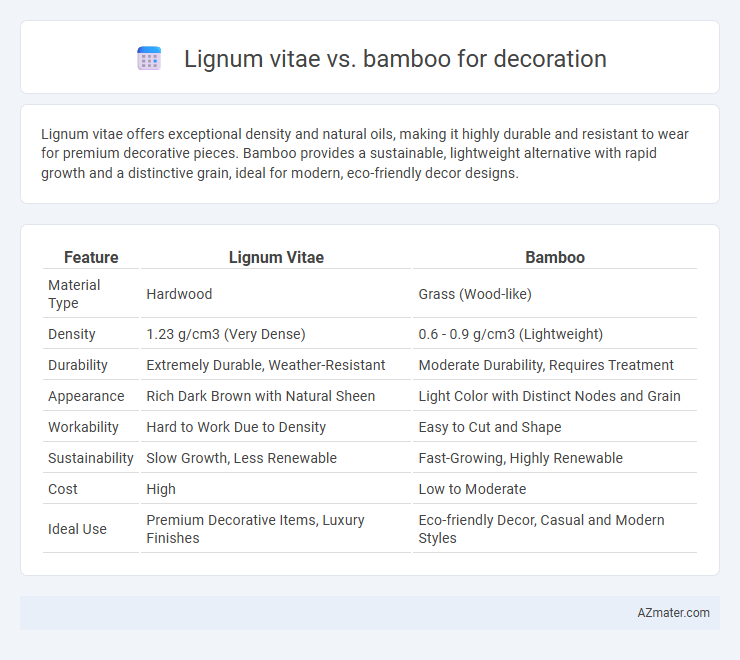Lignum vitae offers exceptional density and natural oils, making it highly durable and resistant to wear for premium decorative pieces. Bamboo provides a sustainable, lightweight alternative with rapid growth and a distinctive grain, ideal for modern, eco-friendly decor designs.
Table of Comparison
| Feature | Lignum Vitae | Bamboo |
|---|---|---|
| Material Type | Hardwood | Grass (Wood-like) |
| Density | 1.23 g/cm3 (Very Dense) | 0.6 - 0.9 g/cm3 (Lightweight) |
| Durability | Extremely Durable, Weather-Resistant | Moderate Durability, Requires Treatment |
| Appearance | Rich Dark Brown with Natural Sheen | Light Color with Distinct Nodes and Grain |
| Workability | Hard to Work Due to Density | Easy to Cut and Shape |
| Sustainability | Slow Growth, Less Renewable | Fast-Growing, Highly Renewable |
| Cost | High | Low to Moderate |
| Ideal Use | Premium Decorative Items, Luxury Finishes | Eco-friendly Decor, Casual and Modern Styles |
Introduction to Lignum Vitae and Bamboo
Lignum vitae, known as one of the densest and hardest woods, offers exceptional durability and natural resin that provides water resistance, making it ideal for high-end decorative pieces. Bamboo, a rapidly renewable grass, stands out for its lightweight, flexibility, and eco-friendly attributes, favored in modern and minimalist decor styles. Both materials bring unique aesthetic and functional qualities to decoration, with lignum vitae showcasing rich, dark hues and bamboo offering a natural, bright finish.
Aesthetic Appeal: Comparing Visual Characteristics
Lignum vitae features a rich, deep brown color with subtle greenish hues and a fine, interlocked grain that offers a unique, luxurious visual texture for decoration. Bamboo presents a lighter, more uniform cream to pale yellow tone with natural nodes adding distinctive linear patterns, creating a minimalist and modern aesthetic. The dense, polished surface of lignum vitae contrasts with bamboo's smooth, yet fibrous finish, making each suitable for different interior styles emphasizing either traditional elegance or contemporary simplicity.
Durability and Longevity in Decorative Uses
Lignum vitae offers exceptional durability and natural resistance to decay, making it ideal for long-lasting decorative applications where toughness is essential. Bamboo, while less dense, provides impressive flexibility and rapid renewability, but it typically requires protective treatments to enhance its lifespan in decorative uses. Both materials excel in aesthetic appeal, yet lignum vitae outperforms bamboo in terms of longevity under harsh or outdoor conditions.
Sustainability and Environmental Impact
Lignum vitae, known for its extreme density and natural oils, is a slow-growing hardwood often harvested unsustainably, raising concerns about deforestation and habitat loss. Bamboo, a rapidly renewable grass, grows up to several feet per day, making it a highly sustainable choice with a minimal environmental footprint due to its carbon sequestration ability and soil erosion prevention. For eco-friendly decoration, bamboo offers superior sustainability and a lower environmental impact compared to the resource-intensive lignum vitae.
Versatility in Interior Design Applications
Lignum vitae offers exceptional durability and a rich, dark hue that enhances luxury interior decor, making it ideal for high-end furniture and decorative accents. Bamboo's lightweight structure and natural flexibility allow for innovative design applications, such as wall panels, flooring, and eco-friendly furniture, providing versatility in both modern and rustic interiors. Combining sustainability with unique textures, bamboo adapts seamlessly to various styles, while lignum vitae's density ensures longevity and a premium finish.
Maintenance Requirements: Ease of Care
Lignum vitae requires minimal maintenance due to its natural oils and dense grain, making it highly resistant to moisture, pests, and decay, which significantly reduces the need for frequent treatments or sealing. Bamboo, while also relatively low-maintenance, benefits from regular cleaning and occasional sealing to prevent moisture damage and maintain its aesthetic appeal over time. Both materials offer durability, but Lignum vitae's inherent density provides superior longevity with less routine care compared to bamboo's more moderate maintenance needs.
Cost Comparison: Affordability and Value
Lignum vitae is significantly more expensive than bamboo due to its density, durability, and rarity, making it a luxury option for high-end decorations. Bamboo offers an affordable alternative, delivering excellent value with rapid renewability and cost-effective harvesting methods. When prioritizing budget-friendly decor without sacrificing natural beauty, bamboo stands out as the economical choice.
Cultural and Historical Significance
Lignum vitae, historically prized in Caribbean and Mediterranean cultures, symbolizes durability and spiritual strength through its dense, slow-growing hardwood used in religious artifacts and traditional tools. Bamboo holds profound cultural importance across Asian countries, representing resilience, flexibility, and prosperity, frequently featured in art, architecture, and ceremonial items. Both materials embody deep-rooted heritage and offer unique decorative appeal reflecting their storied backgrounds in global traditions.
Suitability for Outdoor vs. Indoor Decoration
Lignum vitae offers exceptional durability and natural resistance to moisture and insects, making it highly suitable for outdoor decoration in harsh climates. Bamboo, while eco-friendly and lightweight, performs best indoors or in sheltered outdoor spaces due to its lower resistance to prolonged exposure to moisture and UV rays. Choosing between lignum vitae and bamboo depends on whether the decorative application prioritizes long-lasting outdoor resilience or lightweight, sustainable indoor aesthetics.
Final Thoughts: Choosing Between Lignum Vitae and Bamboo
Lignum vitae offers exceptional durability and a rich, dark appearance, making it ideal for high-end decorative projects that require longevity and elegance. Bamboo provides a sustainable, lightweight alternative with a modern aesthetic and versatility, perfect for eco-friendly designs and contemporary interiors. Choosing between Lignum vitae and bamboo depends on the priority of durability versus sustainability and the desired visual impact in your decorative application.

Infographic: Lignum vitae vs Bamboo for Decoration
 azmater.com
azmater.com